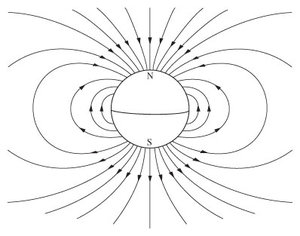Dipole
|
|
- This article is about the electromagnetic phenomenon. From the point of view of the mathematics of distributions, a dipole can be taken to be the directional derivative of a Dirac delta function. A dipole is also a type of radio antenna.
When placed in an electric (E) or magnetic (B) field, equal but opposite forces arise on each side of the dipole creating a torque τ:
- τ = p × E (Electric dipole moment p)
- τ = μ × B (Magnetic dipole moment μ)
- (note: × corresponds to a vector cross product)
which will tend to align the dipole with the field.
| Contents [hide] |
Physical dipoles, point dipoles, and approximate dipoles
A physical dipole consists of two equal and opposite point charges: literally, two poles. Its field at large distances (i.e., distances large in comparison to the separation of the poles) depends almost entirely on the dipole moment as defined above. A point (electric) dipole is the limit obtained by letting the separation tend to 0 while keeping the dipole moment fixed. The field of a point dipole has a particularly simple form, and the order-1 term in the multipole expansion is precisely the point dipole field.
There's no such thing as a magnetic physical dipole, since there are (so far as is known) no magnetic monopoles. A magnetic point dipole has a magnetic field of the exact same form as the electric field of an electric point dipole. A very small current-carrying loop is approximately a magnetic point dipole; the magnetic dipole moment of such a loop is the product of the current flowing in the loop and the (vector) area of the loop.
Any configuration of charges or currents has a dipole moment, which describes the dipole whose field is the best approximation, at large distances, to that of the given configuration. This is simply one term in the multipole expansion; when the charge ("monopole moment") is 0 — as it always is for the magnetic case, since there are no magnetic monopoles — the dipole term is the dominant one at large distances: it falls off in proportion to 1/r3, as compared to 1/r4 for the next (quadrupole) term and higher powers of 1/r for higher terms.
Molecular dipoles
Many molecules have such dipole moments due to non-uniform distributions of positive and negative charges on the various atoms. For example:
(positive) H-Cl (negative)
A molecule with a permanent dipole moment is called a polar molecule and is polarized. The physical chemist Peter J. W. Debye was the first scientist to study molecular dipoles extensively, and dipole moments are consequently measured in units named debye in his honor.
With respect to molecules there are three types of dipoles:
- Permanent dipoles: These occur when 2 atoms in a molecule have substantially different electronegativity — one atom attracts electrons more than another becoming more negative, while the other atom becomes more positive. See dipole-dipole attractions.
- Instantaneous dipoles: These occur due to chance when electrons happen to be more concentrated in one place than another in a molecule, creating a temporary dipole. See Instantaneous dipole attraction.
- Induced dipoles These occur when one molecule with a permanent dipole repels another molecule's electrons, "inducing" a dipole moment in that molecule. See induced-dipole attraction.
Field of a point dipole
The strength, B, of a dipole magnetic field is given by:
- <math>\mathbf{B}(\mathbf{r}, \lambda) = (\mu_0/4\pi)(\mathbf{M}/\mathbf{r}^3)(1+3\sin^2\lambda)^{1\over2}<math>
where:
- B is the strength of the field, measured in teslas
- r is the distance from the center, measured in metres
- λ is the magnetic latitude (90°-θ) where θ = magnetic colatitude, measured in radians or degrees (magnetic colatitude is 0 along the dipole's axis and 90° in the plane perpendicular to its axis)
- M is the dipole moment, measured in ampere square-metres
- μ0 is the permeability of free space, measured in henrys per metre.
That's the magnitude of the field; the field itself is a vector quantity:
- <math>\mathbf{B}(\mathbf{r}) = (\mu_0/4\pi r^3)\left(3(\mathbf{m}\cdot\hat{\mathbf{r}})\hat{\mathbf{r}}-\mathbf{m}\right)<math>
where
- B is the field
- r is the vector from the position of the dipole to the position where the field is being measured
- r is the absolute value of r: the distance from the dipole
- <math>\hat{\mathbf{r}} = \mathbf{r}/r<math> is the unit vector parallel to r
- m is the (vector) dipole moment
- μ0 is the permeability of free space
This is exactly the field of a point dipole, exactly the dipole term in the multipole expansion of an arbitrary field, and approximately the field of any dipole-like configuration at large distances.
The vector potential A is
- <math>\mathbf{A}(\mathbf{r}) = (\mu_0/4\pi r^2)(\mathbf{m}\times\hat{\mathbf{r}})<math>
with the same definitions as above.
The electric field of an electric point dipole is
- <math>\mathbf{E}(\mathbf{r}) = (1/4\pi\epsilon_0 r^3)\left(3(\mathbf{p}\cdot\hat{\mathbf{r}})\hat{\mathbf{r}}-\mathbf{p}\right)<math>
where
- E is the field
- r, r, <math>\hat{\mathbf{r}}<math> are as above
- p is the (vector) dipole moment
- ε0 is the permittivity of free space.
Notice that this is formally identical to the magnetic field of a point magnetic dipole; only a few names have changed.
The (scalar) potential is
- <math>V(\mathbf{r}) = (1/4\pi\epsilon_0 r^2)(\mathbf{p}\cdot\hat{\mathbf{r}}).<math>
External links
- USGS Geomagnetism Program (http://geomag.usgs.gov)
de:Dipol fr:Dipôle it:Dipolo magnetico nl:Dipool ja:双極子 pl:Elektryczny moment dipolowy sl:električni dipol

